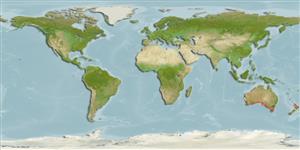Acanthopagrus butcheri (Munro, 1949)
Black bream
Добавить Ваши наблюдения в Fish Watcher
| Native range | All suitable habitat | Point map | Year 2050 |

|
| This map was computer-generated and has not yet been reviewed. |
| Acanthopagrus butcheri AquaMaps Data sources: GBIF OBIS |
Загрузить свой Фото и Видео
Pictures | Изображение на GoogleAcanthopagrus butcheri
Picture by Good, P.
Pictures | Изображение на GoogleAcanthopagrus butcheri
Picture by Good, P.
Common names from other countries
Классификация / Names народные названия | синонимы | Catalog of Fishes(род, виды) | ITIS | CoL | WoRMS | Cloffa
> Eupercaria/misc (Various families in series Eupercaria) > Sparidae (Porgies)
Etymology: Acanthopagrus: Greek, akantha = thorn + Greek, pagros, a kind of fish (Ref. 45335).
Eponymy: Alfred Dunbavin Butcher (1915–1990) was an Australian zoologist. [...] (Ref. 128868), visit book page.
Etymology: Acanthopagrus: Greek, akantha = thorn + Greek, pagros, a kind of fish (Ref. 45335).
Eponymy: Alfred Dunbavin Butcher (1915–1990) was an Australian zoologist. [...] (Ref. 128868), visit book page.
Environment: milieu / climate zone / depth range / distribution range экология
морской; пресноводный; солоноватоводный демерсальный. Subtropical; 23°S - 44°S, 112°E - 154°E
распространение страны | регионы FAO | Ecosystems | места находок | Point map | интродукции | Faunafri
Indo-Pacific: endemic to southern Australia.
Length at first maturity / Size / Вес / Возраст
Maturity: Lm ?, range 16 - ? cm
Max length : 60.0 cm TL самец/пол неопределен; (Ref. 2156); common length : 24.0 cm TL самец/пол неопределен; (Ref. 2156); наибольший вес (опубликованные данные): 4.0 kg (Ref. 26523); наибольший возраст (опубликованны данные): 29 годы (Ref. 36820)
Max length : 60.0 cm TL самец/пол неопределен; (Ref. 2156); common length : 24.0 cm TL самец/пол неопределен; (Ref. 2156); наибольший вес (опубликованные данные): 4.0 kg (Ref. 26523); наибольший возраст (опубликованны данные): 29 годы (Ref. 36820)
Краткое описание определительные ключи | морфология | морфометрия
колючие лучи спинного плавника (общее число) : 10 - 13; членистые (мягкие) лучи спинного плавника (общее число) : 10 - 13; колючие лучи анального плавника: 3; членистые (мягкие) лучи анального плавника: 8 - 10. The upper body can vary from silvery to golden brown, bronze, green or black depending on habitat. Chin and belly are usually white and fins are dusky to greenish black. Dorsal and ventral profiles of adults are similarly convex.
Endemic in coastal areas, rivers and estuaries of Australia. Most abundant in river mouths and estuaries (Ref. 28468, 28472). Inhabit brackish waters of coastal rivers and lakes, occasionally penetrating fresh water (Ref. 44894). Considered as the only true estuarine sparid in Australia. Larvae and small juveniles are most abundant over seagrass beds in shallow estuarine waters (Ref. 28468, 28472). Spawning period varies considerably between estuaries (Ref. 28468). Remain upstream in sheltered waters to spawn and is not usually found in purely marine habitats (Ref. 44894). Feed on shellfish, worms, crustaceans, small fish and algae. Sold as whole, chilled products in domestic markets (Ref. 6390). One of top angling species in southern Australia (Ref. 6390, 44894), as well as being a delicious table fish (Ref. 2156).
Life cycle and mating behavior половая зрелость | размножение | нерест | икра | Fecundity | личинки
It is not known whether there is any sex inversion in black bream (Ref. 6390).
Основная ссылка
Upload your references | ссылки | координатор | соавторы
Kailola, P.J., M.J. Williams, P.C. Stewart, R.E. Reichelt, A. McNee and C. Grieve, 1993. Australian fisheries resources. Bureau of Resource Sciences, Canberra, Australia. 422 p. (Ref. 6390)
Статус Красного Списка МСОП (Ref. 130435: Version 2024-1)
Не вызывающий беспокойства (LC) ; Date assessed: 04 December 2009
Угроза для людей
Harmless
Использование человеком
рыболовство: коммерческий; объект спортивного рыболовства: да
FAO(Publication : search) | FishSource |
дополнительная информация
Population dynamics
Growth parameters
Max. ages / sizes
Length-weight rel.
Length-length rel.
Размерный состав
Mass conversion
пополнение
численность
Growth parameters
Max. ages / sizes
Length-weight rel.
Length-length rel.
Размерный состав
Mass conversion
пополнение
численность
Life cycle
размножение
половая зрелость
Fecundity
нерест
Spawning aggregations
икра
Развитие икры
личинки
динамика численности личинок
размножение
половая зрелость
Fecundity
нерест
Spawning aggregations
икра
Развитие икры
личинки
динамика численности личинок
Anatomy
жаберная область
Brain
Otolith
жаберная область
Brain
Otolith
Physiology
Body composition
Nutrients
Oxygen consumption
Swimming type
Swimming speed
Visual pigments
Fish sound
Diseases & Parasites
Toxicity (LC50s)
Body composition
Nutrients
Oxygen consumption
Swimming type
Swimming speed
Visual pigments
Fish sound
Diseases & Parasites
Toxicity (LC50s)
Genetics
генетика
Heterozygosity
наследуемость
генетика
Heterozygosity
наследуемость
Human related
Aquaculture systems
особенности рыбоводства
степень растяжения
Ciguatera cases
Stamps, coins, misc.
Aquaculture systems
особенности рыбоводства
степень растяжения
Ciguatera cases
Stamps, coins, misc.
инструменты
Bio-Quiz | E-book | полевой определитель | Длина-Частота | онтогенез | карта точек | Classification Tree
| Catch-MSY |
Специальные отчеты
Проверить содержание в аквариумах | Проверить опубликованные видовые данные | Проверить опубликованные данные по аквакультуре
Скачать в формате XML
ресурсы в Интернет
Aquatic Commons | BHL | Cloffa | BOLDSystems | Websites from users | Проверить FishWatcher | CISTI | Catalog of Fishes(род, виды) | DiscoverLife | ECOTOX | Faunafri | Fishtrace | GenBank(Геном, Нуклеотид) | GloBI | GOBASE | | Google Books | Google Scholar | Google | IGFA World Record | MitoFish | Otolith Atlas of Taiwan Fishes | PubMed | Reef Life Survey | Scirus | SeaLifeBase | Tree of Life | Wikipedia(Вперёд, поиск) | World Records Freshwater Fishing | Zoological Record
Estimates based on models
Preferred temperature (Ref. 115969): 14.7 - 20.6, mean 17.6 (based on 126 cells).
Phylogenetic diversity index (Ref. 82804): PD50 = 0.5000 [Uniqueness, from 0.5 = low to 2.0 = high].
Bayesian length-weight: a=0.01259 (0.01137 - 0.01394), b=3.04 (3.01 - 3.07), in cm Total Length, based on LWR estimates for this species (Ref. 93245).
Trophic level (Ref. 69278): 3.5 ±0.53 se; based on food items.
устойчивость к внешним воздействиям (Ref. 120179): низкий, минимальное время удвоения популяции 4.5-14 лет (K=0.11; tm=2-5; tmax=29).
Fishing Vulnerability (Ref. 59153): Moderate vulnerability (41 of 100).




